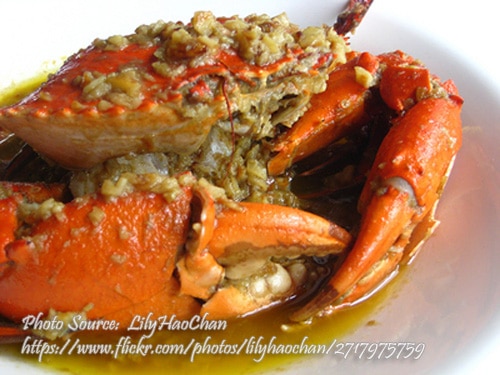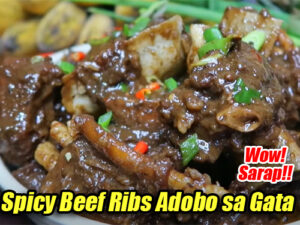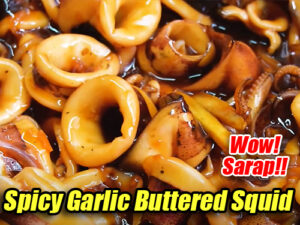Most Filipinos are not very fond of Vietnamese or Thai dishes because of the strong spicy taste. But in fairness most of their dishes are tasty like this garlic roasted crab. There is a Vietnamese restaurant in the U.S. called Thang Long (means “rising dragon”, an old name for Hanoi) where this signature dish came from. Nobody minds the price tag of this dish maybe because it was so delicious. Maybe what makes it so delicious is the kind of crab they are using for this dish, which is a Dungeness crab but we have our own mudcrabs or locally known as “alimango” that can be an ideal substitute.
Vietnamese Style Garlic Roasted Crab: A Nostalgic Seafood Delight
I still remember the first time I had garlic roasted crab. It was during a family reunion at my cousin Aling Nena’s house in Pangasinan, where seafood feasts were a staple. She had learned the recipe from her brother-in-law, Tito Ruben, who had worked in the U.S. for years and often raved about a Vietnamese restaurant called Thang Long. “This is their bestseller,” he said, cracking open a bright orange crab shell with his bare hands, the aroma of garlic and butter filling the air. True enough, one bite and I was hooked. The sweet, tender crab meat coated in garlicky, buttery goodness was nothing short of irresistible.
The Secret to an Irresistible Garlic Roasted Crab
What makes this dish stand out is its simplicity. Unlike many Filipino seafood dishes that come with rich sauces or coconut milk, this one relies on fresh ingredients and precise cooking techniques to bring out the natural flavors. While Thang Long uses Dungeness crab, we in the Philippines have our very own alimango—meaty, succulent, and just as perfect for this dish.
The first step in preparing the crabs is boiling them in a mixture of salt, pepper, water, and crushed garlic. This does two things: it ensures that the crab meat absorbs the seasonings from the inside out, and it also partially cooks the crabs before roasting. Boiling for just about five minutes per three-fourths kilo of crab is key—you want them to turn that vibrant orange color without overcooking.
Once boiled, the crabs are cut into manageable pieces. If you’re like my brother, who insists on getting the best bits, don’t forget to crack the claws. This lets the flavors seep into every crevice, making every bite just as flavorful as the last.
The Magic of Garlic, Butter, and Olive Oil
One of the highlights of this dish is the rich, garlicky sauce. If there’s one thing my auntie Luz taught me in the kitchen, it’s that when using garlic, patience is key. Instead of frying it too quickly over high heat, letting it slowly turn golden brown in a mixture of butter and olive oil releases its natural sweetness without the bitterness that burnt garlic can bring. This technique ensures a smooth, fragrant sauce that perfectly coats the crab meat.
The trick here is balance—garlic roasted crab is not just about throwing in a ton of garlic. It’s about sautéing it gently until fragrant, then adding just enough salt and pepper to bring out the umami without overpowering the natural sweetness of the crab. And of course, butter adds that rich, indulgent flavor that makes this dish unforgettable.
Why Roasting Brings Out the Best Flavor
After coating the crabs in this garlicky butter sauce, the final step is roasting them in the oven for about 10 minutes. This technique does two things: it allows the flavors to meld beautifully, and it gives the crab shells a slightly crisp texture that makes breaking them open even more satisfying. Tito Ruben swears that this step is what elevates the dish, and after years of making it myself, I couldn’t agree more. The gentle heat caramelizes the garlic, deepens the buttery flavor, and makes the crab even more aromatic.
Once out of the oven, a final sprinkle of salt and pepper seals the deal. Served straight from the dish, shells glistening with garlic-infused oil, it’s impossible to resist picking up a piece and diving right in.
A Dish Worth Sharing
Garlic roasted crab is more than just a meal—it’s an experience. It’s messy, it’s flavorful, and it’s best enjoyed with family gathered around the table, sleeves rolled up, cracking shells and licking buttery fingers. I think that’s why this dish has gained such popularity, not just in Vietnamese cuisine but in Filipino households as well.
In a way, this recipe bridges cultures. While it has its roots in Vietnam, its appeal transcends borders, and Filipinos, with our love for bold flavors, have embraced it wholeheartedly. Whether using Dungeness crab or our own alimango, this dish proves that good food doesn’t need to be complicated—it just needs the right ingredients and a little bit of heart.
Next time you find yourself with fresh crabs on hand, try making this Vietnamese-style garlic roasted crab. Who knows? It might just become a new family favorite, just as it did for mine. After all, some of the best memories are made around the dinner table, with the people we love, sharing dishes that tell stories of tradition, travel, and togetherness.
How to cook Vietnamese Style Garlic Roasted Crab
Ingredients
- 4 pcs Mud crabs alimango about 3/4 to 1 kilo each, cleaned and top shell opened
- 1 whole head garlic minced
- 2 Tbsp. whole cracked pepper divided
- 2 Tbsp. salt
- 1/4 cup water
- 1 to 2 cups olive oil or you can combine salad oil and olive oil
- 1/4 cup butter
- 1 whole head garlic crushed
- salt and pepper to taste
Instructions
How to cook Vietnamese Style Garlic Roasted Crab:
- Preheat oven to 350 °F. Clean crabs well. Put crabs, minced garlic, crushed pepper, 2 Tbsp. salt, and the water in a pot.
- Bring to a boil (5 minutes per 3/4 kilo of crabs). When the crabs turn orange, divide each crab into 4 if crabs are 1 kilo and into two parts if the crabs are half a kilo size. You can also crack the claws.
- In a separate deep pan, heat olive oil, butter, crushed garlic, a little salt and pepper.
- Add the crabs and saute until well coated but don't fry. Arrange in an oven-proof dish and cook in the oven for 10 minutes.
- Sprinkle with a mixture of salt and pepper and serve with the shells on top.
Notes
Cooking Tips:
Choose the Freshest Crabs for the Best Flavor
Fresh crabs make all the difference in this dish, as their natural sweetness enhances the garlicky butter sauce. Look for live crabs with active movement, a hard shell, and a briny sea scent. Avoid crabs with a fishy smell or limp legs, as these indicate they are no longer fresh.Master the Art of Garlic Browning
Slowly sautéing garlic over low heat brings out its sweet, nutty flavor without burning it. If the garlic turns too dark too quickly, it can taste bitter and overpower the dish. Stir continuously and remove from heat once it reaches a golden brown to retain its rich, aromatic essence.Roast to Lock in Flavors
Roasting the crab after sautéing helps the garlic-butter mixture penetrate deeper into the meat. The gentle heat also caramelizes the garlic further, enhancing the dish’s overall depth of flavor. A quick 10-minute roast at the right temperature ensures the crab remains juicy while intensifying its delicious aroma.





